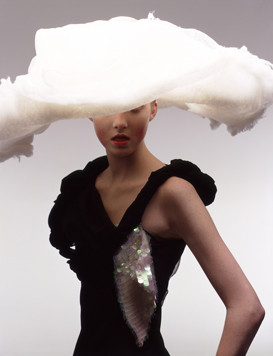Future Beauty
04 Mar - 19 Jun 2011

Yohji Yamamoto
spring / summer 1998
photograph by inez van lamsweerde and
vinoodh matadin
art direction and design by m/m (paris)
courtesy matthew marks gallery, new york
spring / summer 1998
photograph by inez van lamsweerde and
vinoodh matadin
art direction and design by m/m (paris)
courtesy matthew marks gallery, new york
FUTURE BEAUTY
30 years of japanese fashion
4 March - 19 June, 2011
"nothing seen before, nothing repeated before; instead, new discoveries that gaze into the future, that are liberated and alive." comme des garçons
"future beauty" is the first comprehensive overview of japanese avant-garde fashion of the past 30 years to be presented in europe. in the early 1980s, japanese designers like rei kawakubo, issey miyake and yohji yamamoto began questioning the western ideals of beauty, and they redefined fashion from scratch. the narrow silhouette of western couture gave way to flowing forms and a reduced, monochrome range of colours – nothing was to detract from the cut and proportion of a piece of clothing. the decorative language was mainly derived from the material: old and defective fabrics were used as well as opulent materials to cloak the human figure and create voluminous space between the fabric and the body. rei kawakubo became famous for the beggar or rag look of her label "comme des garcons". the models from her collection were full of holes, torn and without any distinctive colours. her anarchistic approach, which is still valid today, has made her one of the most influential fashion designers in the world. her work, and that of miyake and yamamoto, are the expression of the japanese concept of beauty known as wabi-sabi. finding beauty in modesty and imperfection.
besides the pioneering designs of kawabuko, miyake and yamamoto, "future beauty" also presents among others japanese fashion of the next generation – pieces by junya watanabe, jun takahashi, tao kurihara as well as jil sander for uniqlo. the exhibition is divided into four sections: in "praise of shadows" covers japanese fashion's preference for dark monochromes; "flatness" focuses on simple geometric shapes and the interplay between two-dimensionality and volume; the section "tradition and innovation" looks at the radical renewal of traditional japanese clothing and textile techniques; and, finally, "cool japan" examines the symbiotic relationship between street style, popular culture and haute couture.
30 years of japanese fashion
4 March - 19 June, 2011
"nothing seen before, nothing repeated before; instead, new discoveries that gaze into the future, that are liberated and alive." comme des garçons
"future beauty" is the first comprehensive overview of japanese avant-garde fashion of the past 30 years to be presented in europe. in the early 1980s, japanese designers like rei kawakubo, issey miyake and yohji yamamoto began questioning the western ideals of beauty, and they redefined fashion from scratch. the narrow silhouette of western couture gave way to flowing forms and a reduced, monochrome range of colours – nothing was to detract from the cut and proportion of a piece of clothing. the decorative language was mainly derived from the material: old and defective fabrics were used as well as opulent materials to cloak the human figure and create voluminous space between the fabric and the body. rei kawakubo became famous for the beggar or rag look of her label "comme des garcons". the models from her collection were full of holes, torn and without any distinctive colours. her anarchistic approach, which is still valid today, has made her one of the most influential fashion designers in the world. her work, and that of miyake and yamamoto, are the expression of the japanese concept of beauty known as wabi-sabi. finding beauty in modesty and imperfection.
besides the pioneering designs of kawabuko, miyake and yamamoto, "future beauty" also presents among others japanese fashion of the next generation – pieces by junya watanabe, jun takahashi, tao kurihara as well as jil sander for uniqlo. the exhibition is divided into four sections: in "praise of shadows" covers japanese fashion's preference for dark monochromes; "flatness" focuses on simple geometric shapes and the interplay between two-dimensionality and volume; the section "tradition and innovation" looks at the radical renewal of traditional japanese clothing and textile techniques; and, finally, "cool japan" examines the symbiotic relationship between street style, popular culture and haute couture.
